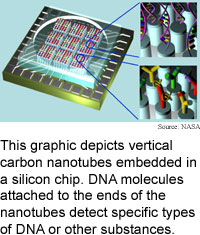
Chip senses trace DNA
By
Eric Smalley,
Technology Research NewsThe tricorders in science fiction's Star Trek instantly read minuscule amounts of DNA left in a room days after a person passes through.
In reality, however, DNA detection happens in the laboratory and involves replicating the molecules in order to make samples large enough to sense, then adding fluorescent dyes and reading each sample with the help of lasers.
Research aimed at building handheld DNA detectors could dramatically narrow the gap between fiction and reality within just a few years. The key to making a handheld DNA detector is sidestepping replication by finding a way to detect extremely small amounts of DNA.
Scientists at NASA Ames Research Center have come a step closer to the sensor used by the agency's fictional descendant by developing an ultrasensitive electronic DNA detector that employs a forest of carbon nanotubes to sense meager amounts of DNA. Carbon nanotubes are rolled-up sheets of carbon atoms.
Unlike DNA detectors that are based on conventional fluorescence, the electronic DNA chip can be readily miniaturized and automated, and can test for a wide range DNA at once, said Jun Li, a researcher at NASA. The detector can also sense other substances, including proteins, chemicals and pathogens. "It is a very versatile platform that can be used for many purposes," said Li.
Previous attempts at electronic DNA chips have produced devices that were still orders of magnitude less sensitive than fluorescence-based DNA chips, according to Li. The NASA device, however, has the potential to reach the sensitivity of laser-based fluorescence techniques, according to Li.
The key to this sensitivity is the small size and electronic properties of carbon nanotubes.
The researchers' prototypes consist of arrays of 2- to 200-square-micron chromium electrodes on a silicon wafer. Multi-walled nanotubes ranging from 30 to 50 nanometers in diameter -- about two orders of magnitude smaller than a red blood cell -- cover the electrodes and are encased in a layer of silicon oxide.
The nanotubes are packed onto the electrodes at densities of anywhere from 100 million to 3 billion nanotubes per square centimeter.
The bottoms of the nanotubes are in contact with the electrode and their tops are exposed at the surface of the silicon oxide layer. Strands of probe DNA are attached to the ends of the nanotubes.
When a liquid sample containing target DNA molecules comes into contact with the detector, the target DNA attaches to the probe DNA, and this increases the flow of electrons through the nanotubes to the electrode. The fewer and more widely spaced the nanotubes, the more sensitive the detector.
The device is at least sensitive enough to detect DNA in samples containing as few as 3.5 million molecules, and is probably capable of detecting DNA in samples with only a few thousand molecules, according to the researchers. A drop of water, in contrast, contains trillions of water molecules.
The carbon nanotube nanoelectrode array could be used as a portable sensor for cancer cells and environmental contaminants, according to Li. "The main applications will be for handheld devices for quick and simple testing, such as personal care for early cancer detection, environmental monitoring, bio defense and space exploration," he said.
The main challenges to using the device for real-world applications are integrating the system into a practical package, and developing appropriate bioassays for each application, according to Li.
The array could be used in practical applications within two years, said Li. A NASA spinoff company, Integrated Nanosystems Inc., is commercializing the system, he said.
Li's research colleagues were Hou Tee Ng, Alan Cassell, Wendy Fan, Hua Chen, Qi Ye, Jessica Koehne, Jie Han and M. Meyyappan. The work appeared in the May 14, 2003 issue of Nano Letters. The research was funded by NASA and the National Cancer Institute.
Timeline: 2 years
Funding: Government, Institute
TRN Categories: Nanotechnology; Biotechnology
Story Type: News
Related Elements: Technical paper, "Carbon Nanotube Nanoelectrode Array for Ultrasensitive DNA Detection," Nano Letters, May 14, 2003.
Advertisements:
July 30/August 6, 2003
Page One
VR accommodates reality
Fractals support growing organs
Eyes off, screen off
Chip senses trace DNA
News briefs:
Laser bursts pierce fog
Electricity loosens tiny bits
Nano light stores data in polymer
See-through magnets hang tough
Munching microbes feed fuel cell
Crystal cracks nurture nanowires

News:
Research News Roundup
Research Watch blog
Features:
View from the High Ground Q&A
How It Works
RSS Feeds:
News
Ad links:
Buy an ad link
| Advertisements:
|
 |
Ad links: Clear History
Buy an ad link
|
TRN
Newswire and Headline Feeds for Web sites
|
© Copyright Technology Research News, LLC 2000-2006. All rights reserved.